|
Harry Houdini
Answer
to Name
This Famous Person Game - September 2013
|
 |
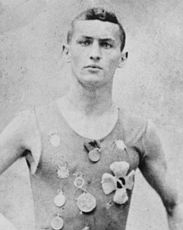 Carlton of Utah, Teresa P. Bland, Robert Bernier of Beaverton, Ontario, Canada, Maureen Ouellette of Dracut, Mass., Sherron Lawson of Roswell, Ga. correctly identified this photo of a very young Harry Houdini. Carlton of Utah, Teresa P. Bland, Robert Bernier of Beaverton, Ontario, Canada, Maureen Ouellette of Dracut, Mass., Sherron Lawson of Roswell, Ga. correctly identified this photo of a very young Harry Houdini.
Despite being world famous for his death-defying escapes, magic tricks and illusions, relatively few know that Harry Houdini was once offered the opportunity to supplant Rasputin as advisor to Czarina Alexandra Feodorovna, wife of Czar Nicholas II. While performing in Russia, word of his “powers” reached Alexandra who was deeply influenced by spiritualism, and powerful Russians wanted Houdini to replace Rasputin, who was thought to be controlling the throne.
Of this, Houdini said, “No fortune I could hope to gain in any other way would be a tenth part of the reward that would be mine if I accepted…. They had definite assurance that the czarina would cast aside Rasputin for me if I would only announce that I was able to accomplish my feats with the aid of the supernatural.
“How easy I could have deceived her! I was commanded to appear before the emperor and empress. Then at a dinner held in my honor, a toast was proposed to the czar and czarina. I am a teetotaler…. I had left my glass turned down and I merely raised it empty when the others drank. My actions were misinterpreted as a slight to the monarchs, and Rasputin…made the most of the incident. Disappointed but not discouraged, the tempters who desired to make me the premier charlatan of Russia begged me to wait for a more propitious moment, and they would yet make me the favorite of the court.
| “I left Russia, promising to return when they were ready for me. But I had no intention of doing so. Once away from the country, I saw how utterly absurd it would have been to sell my birthright of trickery, even for such a stupendous price. I could not have lived the lie that would have been necessary even though the world had been the reward.
“Yet, I, a Jew—hated of the Russians—might have been the real ruler of the vast country. Perhaps, after all, in view of the destruction to which Rasputin led the empire, it had been better for me to have accepted.
“ ‘You, at least,’ one of the Russians who wanted to have me installed at court had argued, ‘are not a madman; you will not, you could not be the terrible menace to our country that Rasputin is.’ And, of course, I could not have been. It may be that I, had I superseded the mad monk, could have gradually disillusioned the mystical empress. Had I possessed the ‘mediumistic’ power to foresee what Rasputin would do to the country, I might have stepped out as Rasputin’s rival. By so doing, perhaps I could have saved an empire from complete collapse.”1
That close call with a world-changing event had a humble beginning. Although Harry Houdini claimed to be born in Appleton, Wisconsin, documents show his birthplace as Budapest, Hungary, on March 24, 1874. Rabbi Weiss brought his family to America when Harry/Ehrich was four. Houdini began his magic career as Eric the Great at the age of 17.
|
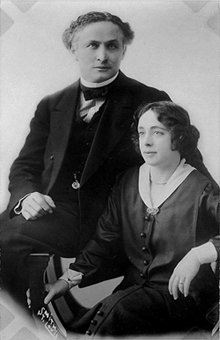
Harry Houdini and his wife Bess.
|
After eight years of performing in small towns, Houdini’s act caught the eye of a manager who got him on the vaudeville circuit. Handcuffs became his ticket to stardom because of his uncanny ability to escape from them, and he was soon heralded in America and Europe as the "King of the Handcuffs." He developed the skill to pick locks while serving as an apprentice locksmith.
Houdini was also famous for escaping from straitjackets. After mastering the trick, he found audiences unimpressed when he performed it. This led him to add suspense and danger by escaping from a straitjacket while hanging suspended over a city street or a river.
“The easiest way to attract a crowd is to let it be known that at a given time and a given place someone is going to attempt something that in the event of failure will mean sudden death.”2
One of Houdini's most impressive escapes was from a locked, metal milk can filled with milk or water. After being handcuffed, Houdini inserted his 5-foot-5-inch frame into a milk can less than three feet high. The handcuffs were no problem, and neither was the locked can—it had a riveted neck or collar, but the rivets were fake. Houdini simply pushed the top off to escape. The can was hidden from the audience behind a curtain or props, and to lengthen the time the audience thought he was struggling underwater to escape, Houdini often nonchalantly read a newspaper. Then suddenly and panting as if out of breath, he would appear to dumbfounded and cheering audiences. The milk can sat on the stage, still locked.
|
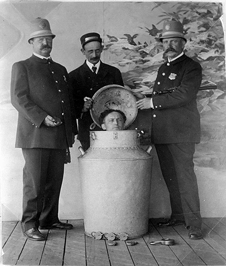
|
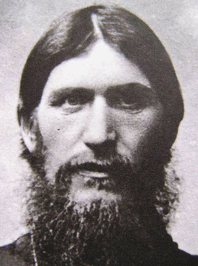
|
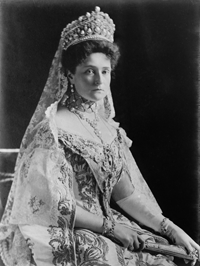
|
| The famous milk can escape.
|
Grigori Rasputin, ca. 1902.
|
Czarina Alexandra Feodorovna,
wife of Czar Nicholas II.
|
You can see why Czarina Alexandra would think he had supernatural powers.
Houdini was also a master of the publicity stunt. He strategically planned free performances of the straitjacket escape while suspended upside down in the air in front of the local newspaper office. Houdini would also have the local police handcuff and lock him up in their most secure cells—sometimes stripped naked—only to have him quickly escape. Houdini achieved this with the help of a swallowed lock pick or key that he regurgitated. 3
“My brain is the key that sets me free."
As a performance artist, it was natural for Harry Houdini to gravitate toward the new medium of his day—the movies. He acted in “Terror Island,” “The Grim Game,” “The Man from Beyond,” and “The Master Mystery,” a serial from the screenwriters of The Perils of Pauline. He also directed and produced movies and created his own studio. At a Swann auction in 2011, an engraved stock certificate for five shares of the Houdini Picture Corporation sold for $4,370.
Today, pre-1910 Houdini memorabilia are rare and sought after by collectors because these predate his becoming legendary. Also, a large part of his effects now reside in institutions, and Houdini directed his brother to burn his papers and equipment after his death. However, he did not comply, and many of his personal effects are in the possession of the Houdini History Center, the Library of Congress and other institutions. Illusionist and magician David Copperfield also owns Houdini memorabilia.
With the passing of his mother Cecelia on July 17, 1913, Houdini sought out mediums to make contact with her and prove that there is an afterlife. Their trickery caused him to wage a personal battle against their defrauding the bereaved of money. He exposed the famous fakers of his day, including the Fox Sisters, Eusapia Palladino, Anna Eva Fay, the Davenport Brothers and others. At a Lawson auction in Australia in February 2013, materials Houdini collected on the Davenport Brothers sold for $13,000 (estimated at $1,500-$2,000).4
Houdini was so successful at revealing frauds that it caused a falling out between him and a famous friend who was a believer in spiritualism—Sir Arthur Conan Doyle.
Contrary to the movies about his life, Harry Houdini did not die in his famous Chinese Water Torture Cell trick. He died from peritonitis, a bacterial disease, which may have been exacerbated by a ruptured appendix and from a college student testing Houdini’s strength with punches to his abdomen.
Despite his condition, Houdini went on to perform for a few more days despite being in intense pain. He was finally taken to a hospital in Detroit, and about a week later on Halloween in 1926, he died.
Also at the Lawson auction, a lot including a letter written by his wife Bess about Houdini being punched in his dressing room and a signed photo sold for $4,500 (with buyer’s premium) against an estimate of $200-$400.5
Harry Houdini was certainly the greatest magician and illusionist of his day and perhaps of all time. He deeply loved his wife, mother and family, and he has had his questions about the afterlife answered.
--------------------------------
1 Modern Mechanics and Inventions, “Houdini’s Mystifying Magic Stunt Exposed,” by R.D. Adams (The Mechanic Who Made Houdini’s Trick Magic Apparatus), Dec. 1929.
2 Ruth Brandon, “The Life and Many Deaths of Harry Houdini,” p. 153.
3 New York Times, “Sidney Radner, Guardian of Houdini Legacy, Dies at 91,” by Paul Vitello, June 26, 2011.
4 www.wildabouthoudini.com.
5 www.wildabouthoudini.com.
Learn
about more Famous People
|